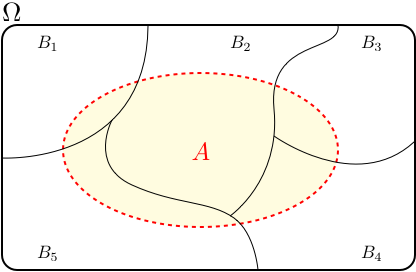Introduction to Probability Models
Lecture 5
Qi Wang, Department of Statistics
Aug 29, 2018
Time for Quiz
Law of Total Probability
If \(B_1, B_2, \cdots, B_n\) forms a partition of \(S\), for any event A: \begin{align} P(A) = & P(A\cap B_1) + P(A\cap B_2) + \cdots + P(A \cap B_n) \\ = & P(A|B_1)\times P(B_1) + P(A|B_2) \times P(B_2) + \\ & \cdots + P(A|B_n) \times P(B_n) \\ = & \sum_{i = 1}^n P(A|B_i) \times P(B_i) \end{align}
Law of Total Probability

Example 1
A box contains 6 white balls and 4 red balls. We randomly (and without replacement) draw two balls from the box. What is the probability that the second ball selected is red?
Example 2
Acme Consumer Goods sells three brands of computers: Mac, Dell, and HP.
30% of the machines they sell are Mac, 50% are Dell, and 20% are HP.
Based on past experience Acme executives know that the purchasers of
Mac machines will need service repairs with probability .2, Dell machines
with probability .15, and HP machines with probability .25.
Find the probability a customer will need service repairs on the computer they purchased from Acme.